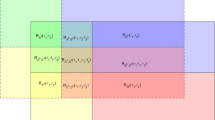Abstract
This paper introduces a novel two-step interference alignment beamforming algorithm for a multiple-antenna interference channel with uncoordinated interference. The proposed algorithm performs subspace division of the signal space by using the total least squares method to use all available degrees of freedom in the system. The algorithm also uses the minimum mean square error as a criterion to maximize the sum rate of the system. Simulation results indicate that the sum rate of the proposed algorithm outperforms the sum rates of previous works in the context of a network with uncoordinated interference. The performance levels of these algorithms are also compared for different uncoordinated interference strengths. Almost the same trend is obtained for the sum rate performance.







Similar content being viewed by others
References
Blum RS. MIMO capacity with interference. IEEE J Sel Areas Commun. 2003;21(5):793–1.
Yang L, Lv J, Xiang Y. Underdetermined blind source separation by parallel factor analysis in time-frequency domain. Cogn Comput. 2012 (in press).
Zheng L, Tse DNC. Diversity and multiplexing: a fundamental tradeoff in multiple-antenna channels. IEEE Trans Inf Theory. 2003;49(5):1073–96.
Gollakota S, Perli SD, Katabi D. Interference alignment and cancellation. In:Proceedings of the ACM SIGCOMM conference on Data communication; 2009. p.159–70.
Cadambe VR, Jafar SA. Interference alignment and degrees of freedom of the K-User interference channel. IEEE Trans Inf Theory. 2008;54(8):3425–41.
Nosrat-Makouei B, Andrews JG, Heath RW. User arrival in MIMO interference alignment networks. IEEE Trans Wirel Commun. 2012;11 (2):842–51.
Maddah-Ali MA, Motahari AS, Khandani AK. Signaling over MIMO multi-base systems: combination of multi-access and broadcast schemes. In: IEEE international symposium on information theory proceedings; 2006. p. 2104–08.
Gomadam K, Cadambe VR, Jafar SA. Approaching the capacity of wireless networks through distributed interference alignment. In: IEEE global telecommunications conference; 2008. p. 1–6.
Peters SW, Heath RW. Interference alignment via alternating minimization. In: IEEE international conference on acoustics, speech and signal processing; 2009. p. 2445–48.
Peters SW, Heath RW. Cooperative algorithms for MIMO interference channels. IEEE Trans Veh Technol. 2011;60(1):206–18.
Lee N, Lim J, Chun J. Degrees of freedom of the MIMO Y channel: signal space alignment for network coding. IEEE Trans Inf Theory. 2009;56(7):3332–42.
Tang Q, Shen Y, Hu C, Zeng J, Gong W. Swarm intelligence: based cooperation optimization of multi-modal functions. Cogn Comput. 2012 (in press).
Wen J, Hung H, Chao C, Cheng C. An effective hybrid GACSA-based multi-user detection for ultra-wideBand communications systems. In:The 5th annual ICST wireless internet conference; 2010. p. 1–7.
Anshika P, Ritu T, Anupam S. Multi-robot exploration in wireless environments. Cogn Comput. 2012 (in press).
Nobakhti A. On natural based optimization. Cogn Comput. 2010;2(2):97–19.
He Z, Xie S, Ding S, Cichocki A. Convolutive blind source separation in frequency domain based on sparse representation. IEEE Audio Speech Lang Process. 2007;15(5):1551–63.
He Z, Xie S, Zdunek R, Zhou G, Cichocki A. Symmetric nonnegative matrix factorization: algorithms and applications to probabilistic clustering. IEEE Trans Neural Netw. 2011;22(12):2117–31.
He Z, Cichocki A, Xie S, Choi K. Detecting the number of clusters in n-way probabilistic clustering. IEEE Trans Pattern Anal Mach Intell. 2010;32(11):2006–21.
Golub GH, Van Loan CF. An analysis of the total least squares problem. SIAM J Numer Anal. 1980;17(6):883–93.
Pearson K. On lines and planes of closest fit to points in space. Phil Mag. 1901;2(11):559–72.
Zhang X. Matrix analysis and applications. Tsinghua University press, Beijing; 2008. p. 403–50.
Shen Y, Wang J. Almost sure exponential stability of recurrent neural networks with Markovian switching. IEEE Trans Neural Netw. 2009;20(5):840–55.
Shen Y, Wang J. An improved algebraic criterion for global exponential stability of recurrent neural networks with time-varying delays. IEEE Trans Neural Netw. 2008;19(3):528–31.
Shen Y, Wang J. Noise-induced stabilization of the recurrent neural networks with mixed time-varying delays and Markovian-switching parameters. IEEE Trans Neural Netw. 2007;18(6):1857–62.
Santamaria I, Gonzalez O, Heath RW, Peters SW. Maximum sum-rate interference alignment algorithms for MIMO channels. In: IEEE global telecommunications conference; 2010. p. 1–6.
Acknowledgments
This work was supported by the key project of National Natural Science Foundation of China under Grant Nos. 61231007 and 61201168 and the major State Science & Technology specific projects of China under Grant No. 2010ZX03005-003.
Author information
Authors and Affiliations
Corresponding author
Rights and permissions
About this article
Cite this article
Zhong, L., Zhu, G., Kong, Z. et al. Distributed Interference Alignment Algorithm for Multiple-Input Multiple-Output Networks with Uncoordinated Interference. Cogn Comput 5, 215–224 (2013). https://doi.org/10.1007/s12559-012-9195-7
Received:
Accepted:
Published:
Issue Date:
DOI: https://doi.org/10.1007/s12559-012-9195-7




